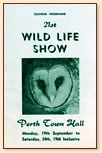|
EARLY
EXHIBITIONS
When Rica's
children started school, she sent the Naturalists' Club the
drawings that she had painted during her early life and while
teaching. They were very favourably received.
 Now,
after the war, the Naturalists' Club started the first Wild
Life Show, and I had been a member in the country for many
years…and I was invited to show something from the
country, which I did. I sent all my paintings - about 60
or 70 of them. You couldn't buy any better paper at the
time, and I sent these down and they were pinned up along
the side wall. I went in one day and I was amused to see
a man trying to pick them off - he thought it was a pressed
flower. It was a spider orchid. One of those little red
spiders and they are so easy to do, you know - to make right
- and he's trying to pick it off and I stood back and looked.
(Battye Library, OH 2528, p. 9) Now,
after the war, the Naturalists' Club started the first Wild
Life Show, and I had been a member in the country for many
years…and I was invited to show something from the
country, which I did. I sent all my paintings - about 60
or 70 of them. You couldn't buy any better paper at the
time, and I sent these down and they were pinned up along
the side wall. I went in one day and I was amused to see
a man trying to pick them off - he thought it was a pressed
flower. It was a spider orchid. One of those little red
spiders and they are so easy to do, you know - to make right
- and he's trying to pick it off and I stood back and looked.
(Battye Library, OH 2528, p. 9)
The Wild
Life Show was a popular annual event in the State's calendar,
organised by the WA Naturalists' Club and the WA Gould League.
It was held in the Perth Town Hall between 1946 and 1972,
and flora and fauna were exhibited and occasionally live animals.
In the 1966 Wild Life Show there was another exhibition of
Rica's paintings, this time featuring the carnivorous plants
of Western Australia.
Encouraged
by the response to the first exhibition at the Wild Life Show
she was persuaded to write a book on orchids illustrated with
her botanical art. In 1951 the first in her series of nature
books was published, Orchids of the West, and this
was followed by Triggerplants in 1958 and Plants
of Prey in Australia in 1968.
|
